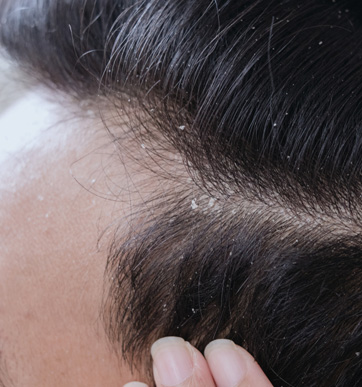
Dandruff – How you get it and how to get rid of it
Do you get flaky in February? After several cold months of dry indoor heat, do you notice tiny white flakes in your hair? Or on your shoulders when you wear a black sweater? Your scalp’s become flaky because dead skin cells are literally flaking off – a natural occurrence. But when it goes into overdrive and the flakes become a noticeable flurry, it’s dandruff. And it’s time to do something about it.
Is It Dry or Oily Dandruff?
Dandruff comes in two types – dry or oily.
Dry dandruff
You have dry dandruff if you have lots of tiny white flakes falling from your scalp and hair onto shoulders. Some flakes may even drift into in your eyebrows.
Oily dandruff
You have oily dandruff if you have greasy yellowish or grayish flakes that stick to your scalp or cling to your hair. This condition is known as seborrheic dermatitis.
Dry dandruff typically responds well to persistent use of over-the-counter anti-dandruff shampoos. You can discuss options with your California Skin Institute dermatologist and find out which one would be best for you.
Dr. Ryan Wells, a board-certified dermatologist and a fellowship-trained Mohs Micrographic Surgeon, at our California Skin Institute – Camarillo location notes “dandruff often occurs with diffuse, mild scaling (flaking) on the scalp. However, when it becomes more intense and there is inflammation or itch involved, it is typically called seborrheic dermatitis. Seborrheic dermatitis is very common and is a bit of a ‘dance’ between a dermatitis and a yeast. It is often treatable with medicated shampoos, but may require topical steroids to improve the condition.”
If you have seborrheic dermatitis, you should see your California Skin Institute dermatologist. They can prescribe prescription shampoos formulated with specific ingredients developed to treat this condition. Your condition also could be a symptom of psoriasis, fungal infections of the scalp, or eczema all of which your California Skin Institute dermatologist can diagnose and treat.
Dandruff Causes
Because you’re alive, all your cells are constantly shedding and renewing themselves. The shedding and renewal process include your scalp.
Your skin, including the skin on your scalp, also produces oil and sweat. That can trap bacteria. If those bacteria levels raise or change, the scalp can become infected leading to seborrheic dermatitis.
Issues such as hormonal changes such as puberty or illness can cause bacteria to multiply leading to excessive shedding or infection. Not shampooing often enough for optimal hair and scalp health can also cause excessive build-up of trapped oils and bacteria. Cold weather combined with dry indoor heat can cause dry flaky dandruff as can a hair care product that causes an adverse reaction.
Dermatologist Tips for Using Dandruff Shampoo
The American Academy of Dermatology offers the following recommendations for using dandruff shampoo:
Read the instruction label: They aren’t all the same. Some say to lather and leave the shampoo on the scalp for an exact amount of time like five minutes. Other shampoos require rinsing immediately.
Alternate dandruff shampoos: Hedge your bets and alternate between different dandruff shampoos with different active ingredients if one alone isn’t working for you.
If you are Asian, Hispanic or Caucasian: Shampoo every day and twice a week with dandruff shampoo.
If you are African American: Shampoo once a week with dandruff shampoo formulated to be best for your hair.
Healthy Scalp, Healthy Hair
For a gorgeous head of hair, you need to start with a healthy scalp. Your scalp is like the flower bed from which the beautiful garden of your hair grows.
 Every hair grows from a follicle. Each hair follicle produces a natural oil called sebum from the sebaceous gland. Sebum helps keep hair healthy and glossy. The amount of sebum varies from person to person. Too much means oily hair that needs more frequent washing; too little means dry hair that can be brittle and more susceptible to damage. But for all kinds of hair it is essential to keep the follicles and the scalp clean and healthy. Follicles that become blocked with built-up sebum or dead skin cells are prone to dandruff and infection. This will affect the overall appearance and quality of your hair.
Every hair grows from a follicle. Each hair follicle produces a natural oil called sebum from the sebaceous gland. Sebum helps keep hair healthy and glossy. The amount of sebum varies from person to person. Too much means oily hair that needs more frequent washing; too little means dry hair that can be brittle and more susceptible to damage. But for all kinds of hair it is essential to keep the follicles and the scalp clean and healthy. Follicles that become blocked with built-up sebum or dead skin cells are prone to dandruff and infection. This will affect the overall appearance and quality of your hair.
Protect your hair and scalp health by calling your California Skin Institute location to schedule an appointment with a board-certified dermatologist.




 / 291 Reviews
/ 291 Reviews